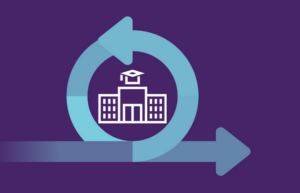
By Rick Valachovic, DMD, MPH, Clinical Professor and Director of the NYU Dentistry Center for Oral Health Policy and Management
The world is changing at a breathtaking pace, yet as the first quarter of the 21st century draws to a close, it feels as though the dental education community is still struggling to achieve consensus on what constitutes a 21st-century dental education.
Beginning in 2005, the ADEA Commission on Change and Innovation in Dental Education (ADEA CCI) created a framework for supporting efforts to modernize our enterprise and disseminate promising practices. Many of our colleagues launched ground-breaking initiatives, published their results, and presented at conferences. Substantial progress was made, but despite these advances, our community still faces some perennial challenges. Chief among these, we need more faculty and innovative ways to develop the skills they will need to successfully lead our institutions.
Whatever the obstacles, dental education must adapt to the current environment, but something seems to be holding us back. I’ve come to believe that the problem is not a lack of ideas but rather a reticence to act in the face of uncertainty. As academics, we are trained to approach our research methodically and to test our results through repeated experimentation. Those steps are critical for building a scientific evidence base, but it takes 17 years on average for research evidence to be implemented in clinical practice.
Where health and even lives are at stake, that level of caution is critically protective, but does it make sense in clinical education? What would happen if we adopted a “fail forward” mindset instead?
“Failing forward” is the idea of creating or implementing something before it is perfected to see how it works in practice and then iterate from there. Such an approach could help us accelerate the pace of educational change. Faculty and staff throughout our community have already conceived dozens of strategies and piloted tools that are ready for replication or adaptation. Not every one of these 21st-century approaches will stand the test of time, but by rapidly implementing them, we would gain insight into what works, what doesn’t, and what can be refined to deliver the best dental education possible today and in the future.
As we consider where to put our energies to ensure that dental education remains strong in the years ahead, do we really need another systematic review before implementing practices that have shown promise over the last two decades? I would argue that we have more than enough evidence to justify embracing some core strategies. Here are ten that stand out to me.
- Focus on core biomedical sciences. Technologies and treatments are constantly evolving – just think of how artificial intelligence and machine learning have evolved since IBM’s Watson debuted on Jeopardy! in 2011 – but the human body and its vulnerabilities change little over time. Strong education in anatomy, physiology, pathology, and pharmacology will remain the foundation of a dental education.
- Teach research and critical thinking skills. Dentists must possess the skills to critically evaluate new science and practice models as they emerge. Schools can prepare students for evidence-based practice by teaching literature review techniques and encouraging participation in research.
- Incorporate technology and innovation. Students’ clinical experiences should prepare them for real-world practice. Schools should endeavor to introduce students to telemedicine, innovative electronic health records, the use of artificial intelligence in diagnosis, robotic surgery, and the other technologies they will likely encounter in state-of-the-art health care environments.
- Offer simulation-based learning. Simulation has proven its effectiveness as a tool for learning and practice. Schools should employ simulation to facilitate the development of various competencies and to fill gaps in students’ clinical experience, such as exposure to certain rare or complex conditions.
- Develop soft skills. Fewer and fewer dentists are working on their own. In today’s health care environment, solid communication and teamwork skills are essential, and leadership is prized. Developing empathy is also critical for delivering culturally respectful, patient-centered care. Schools should strive to foster all these traits.
- Engage in interprofessional education and practice. Create opportunities for learning with students from other health professions (nursing, pharmacy, etc.) to promote collaboration and foster an understanding and appreciation of each profession’s role in patient care.
- Promote adaptability and resilience. Health professionals need the ability to adapt to change and handle stress effectively, a fact driven home by the COVID-19 pandemic. Even under the best of circumstances, it is vital that schools prepare students to adjust as procedures, guidelines, or health care systems undergo change.
- Emphasize ethics and patient-centered care. Schools should strive to acculturate students to their future professional roles throughout their education, teaching them strategies for navigating ethical dilemmas and emphasizing their responsibilities to patients, the profession, and their communities.
- Provide a global health perspective. Whatever the field, a global perspective is an asset in an interconnected world. Schools can find ways to expose students to health and health care beyond the local community. Knowledge of global oral health challenges and alternate models of care delivery will deepen students’ awareness of the value and duties of the dental professions.
- Encourage lifelong learning. Time doesn’t stand still, and neither should working professionals. Because scientific discovery and technological change will continue to reshape dental practice throughout the 21st century, schools should stress the importance of continually updating their graduates’ knowledge and skills. Beyond simple encouragement, schools can offer continuing education to alumni on preferred terms.
Throughout my career, I have always looked to see what trends were on the horizon in order to help our community prepare for whatever was coming our way. The need for leaders as my generation ages into retirement is one recurring theme. If you read last year’s ADEA report, New thinking for the new century: Preparing for the next 100 years, you saw it there as well. In addition to replacing faculty, it called out the need for leaders who can fill the shoes of today’s deans and other academic leaders.
Both these challenges are among my primary concerns, and I’ve taken steps to address them in my current role. At the NYU Dentistry Center for Oral Health Policy and Management, we have developed a portfolio of leadership programs to equip students with leadership skills and instill in them a willingness to serve their communities — whether as faculty at their alma maters or policy influencers on the global stage.
As dental educators, it is incumbent upon us to help students understand the various roles they will need to play and to help them develop the resiliency to adapt to whatever they encounter. I know my colleagues at other institutions share my concerns, and I hope we can spur one another to action. Only by taking risks — and occasionally failing — can we move dental education forward.

Great points— thanks for articulating. What is missing in my view is the need for dental educators to explore and utilize the recommendations from teaching and learning science to develop effective teaching methods.